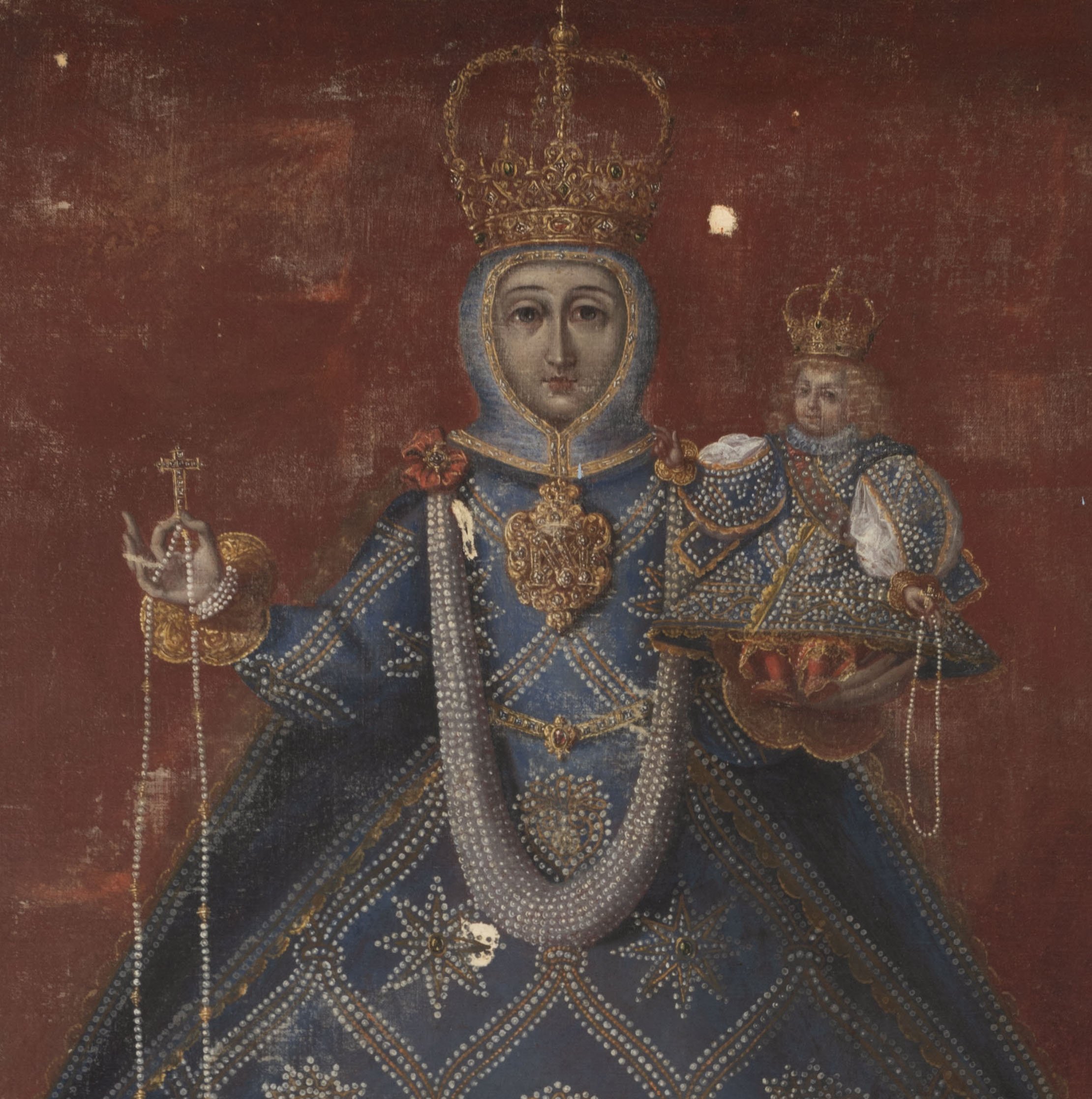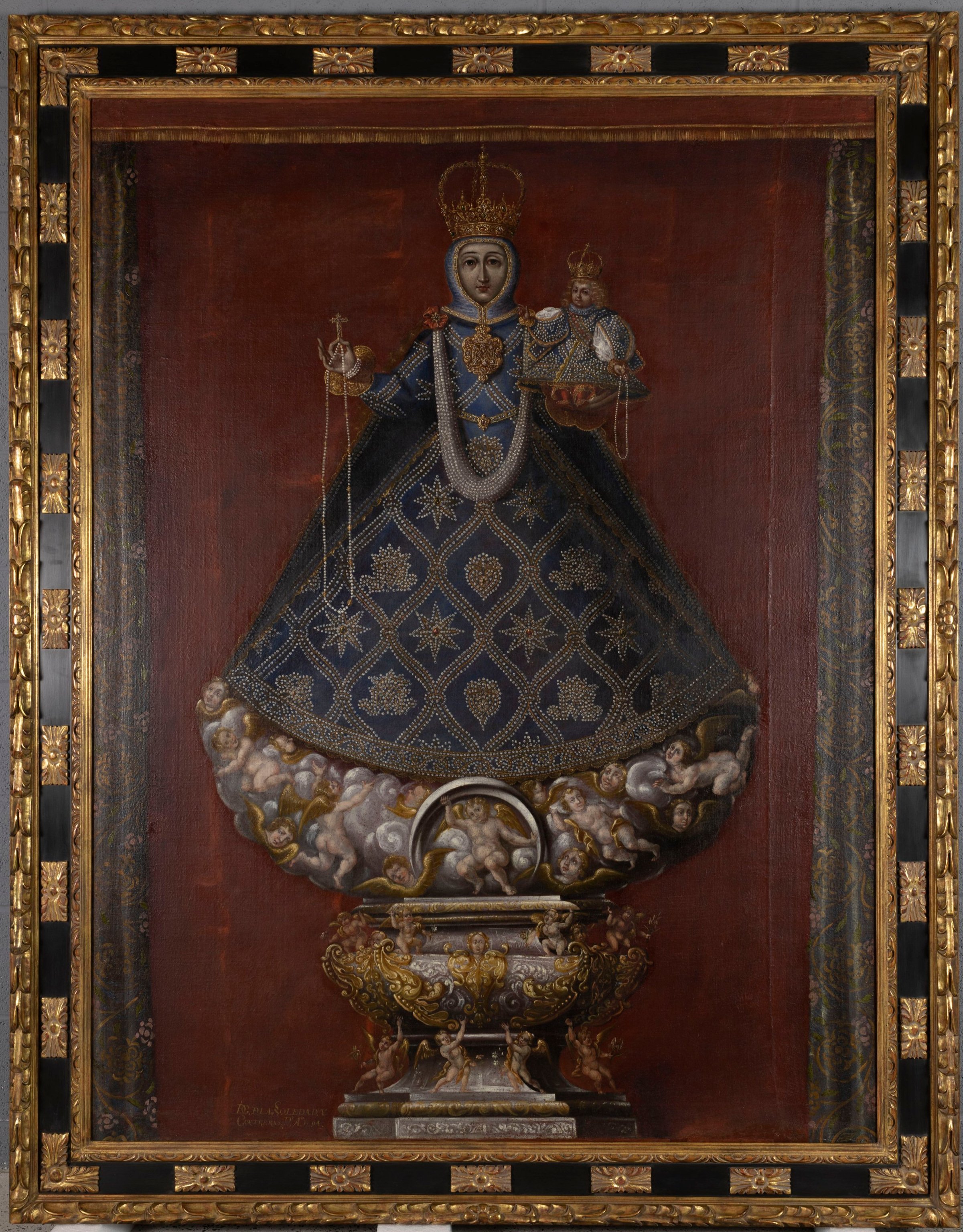Our Lady of Sorrows
Figure 1. Overall, Before Treatment, Normal Light
This painting of the Madonna holding a young Jesus falls into the genre of Marian or statue paintings, which typically depict a statue of Virgin Mary (Figure 1). The Madonna became a powerful symbol with multiple reproductions and reinterpretations within the Spanish Christian Empire, often unique to various local communities. Her imagery could represent spiritual piety, victory, solitude, motherhood, protection, and more. Original statues of the Virgin were rarely moved from the shrine, so pictorial reproductions like prints were used to cheaply recreate the imagery into a more portable format. More expensive than paper prints, paintings like these were also commissioned for display in a church.
Before treatment, the studio researched colonial Spanish American paintings to understand the context, purpose and aesthetics of these works. Because the painting was in a state of incomplete restoration, the aesthetic goal of treatment needed to be determined by looking at other similar paintings and speaking with experts. After discussion with an expert colleague at the Metropolitan Museum of Art, the studio was able to formulate a treatment plan. Thanks to this discussion, the studio was also led to the Project on the Engraved Sources of Spanish Colonial Art (PESSCA) which was crucial in investigating the iconography of the Madonna.
Figure 3. Detail, Before Treatment, Normal Light
To begin treatment, I focused on the painting’s condition issues including bare fill material which starkly contrasted next to original paint; local areas of residual facing material obscuring the iconography; and an unknown, locally applied surface coating that was left in the lower right corner. The canvas has also been wax-resin lined and stretched onto an ICA spring stretcher, the use of which was most prevalent between the 1950’s to 1990’s. In addition the red background and drapery elements appeared highly vulnerable to mechanical damage, with extensive cracking and flaking. The wax-resin lining was largely responsible for helping to keep the paint layer intact overall as the painting continued to experience environmental changes over time.
Without the lining, the paint layer probably would have had more extensive flaking and more significant paint loss.
After a low concentration of a water-soluble consolidant is applied, the area is cleared with a PVOH sponge soaked in a custom aqueous solution to clear excess consolidant and grime from the surface.
The paint flaking and powdering was so extensive that even mechanical action with a brush could cause minor paint loss. Borrowing techniques from wall painting conservation, the red paint was therefore stabilized through simultaneous cleaning and consolidation. A low concentration of a reversible, water-soluble adhesive was brush applied and allowed to sit and penetrate the fractured paint, and then cleared with PVOH sponges using a custom aqueous solution. This process effectively stabilized the paint with minimal losses, and no undesirable changes to gloss or saturation. Overfills, local surface coatings, and residual facing materials were individually tested and reduced. After applying an isolation coating, remaining paint losses were filled with a custom fill material, comparable to BEVA gesso.
Figure 3. Stages of inpainting for a loss in the Madonna’s gown
The old and new fills were then reintegrated using reversible conservation inpainting media. Large areas of complex imagery in Madonna's dress and drapery had been lost. After toning the fills with a background color, I created a Mylar cartoon of the lost design using Photoshop and a perforating tool to punch through the film and mark the design. I then used the Mylar stencil to “pounce” through the holes and map out the lost composition and achieve a more accurate reconstruction. Once inpainting was complete, we varnished the surface to properly saturate the colors and impart a gloss level similar to other colonial South American paintings. Lastly, I attached a protective backing board to the verso.
Figure 4. After treatment in a custom, historically accurate frame by The Art of Framing
The client also commissioned a new historically accurate frame for this painting. The studio was included in discussions throughout the process and we could not be more pleased with the work accomplished by the The Art of Framing in Jenkintown, PA. The painting is now on display at the Frances M. Maguire Art Museum.




